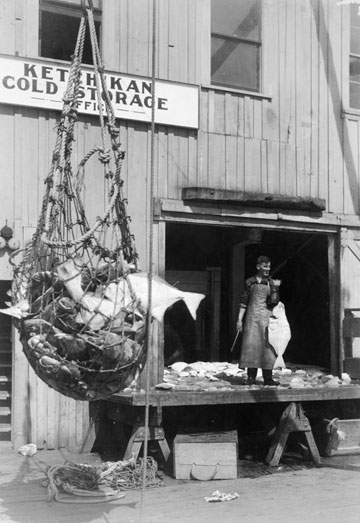 A History of the 'Canned Salmon Capital of the World' By DAVE KIFFER September 23, 2009
Washington-based Fidalgo Island Packing was building a cannery near Inman Hill, just south of Ketchikan Creek and the owners of the Alaska Packers Association Cannery near Loring, 20 miles to the north, were furious. Ketchikan Creek was a prime location for its fishing operations in the area and the APA was not willing to let a newcomer poach its resources. 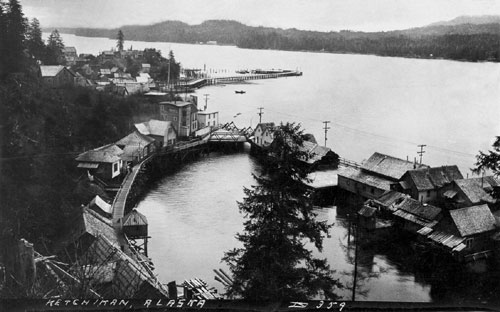 David Nicoll photo; Donor: Irene McGillvray Photograph courtesy Tongass Historical Society 76.7.10.1
Scuffles broke out and more than a few fishermen ended up in the water, but cooler heads prevailed without any serious violence taking place. No Company Owns a Salmon Stream The real war was in the court system as Fidalgo sued the Alaska Packers Association. Several years later, the U.S. Circuit Court of Appeals ruled that no one company can claim exclusive rights to the waterways, that no company owns a salmon stream. Both companies would have to share the lucrative stream. But the fish war had stirred up civic-minded sentiments and by the end of August, 1900 just weeks after the Fidalgo cannery packed its first cases on salmon the city of Ketchikan had incorporated. The first mayor was Mike Martin, one of the managers at the Fidalgo cannery. Martin had lived in the Ketchikan area since the mid 1880s and had operated an early salmon processing facility in Tongass Narrows, as the Ketchikan area was called, prior to 1900. 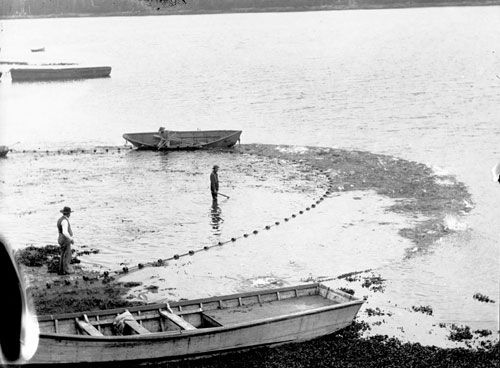 Willis A. Bryant photo; Donor: Arthur Bryant Photograph courtesy Tongass Historical Society 70.7.5.74 Martin's saltery, which processed and packed salmon in barrels of salt for shipping, sold salmon to the Alaska Packers Association in 1896 and 1897, but had its genesis in an even earlier cannery. The Tongass Packing Co. had operated in Tongass Narrows in 1887 to 1889 from a site near the present downtown tunnel. Capt. A.W. Berry had brought that cannery to the Narrows from Boca de Quadra, 40 miles south of Ketchikan and 20 miles north of the Canadian border, where it had operated as the Cape Fox Packing Co. from 1883 to 1886. Tongass Packing burned down in August of 1889, and no cannery would operate again in Tongass Narrows until 1900, but Berry had also purchased land south of the creek that he later sold to Martin and Fidalgo. One of Berry's employees was a man named George Clark who helped Martin found his saltery in the early 1890s but then reportedly went on to work for APA at Loring before the Fidalgo operation was formed. Such is the tangled web of alliances in the early days of Ketchikan's salmon canning industry. It mirrors the early history of Ketchikan itself, as the city grew from primarily a mining industry supply center to a city with more than a dozen canneries and the title of the Salmon Capital of the World by the 1930s. More Canned Salmon Than Any Other City In the 1930s, the Ketchikan Chronicle trumpeted nearly every issue with the phrase "More Canned Salmon is packed in Ketchikan than any other city in the world." A welcome arch had been built near the corner of Mission and Front streets, proclaiming Ketchikan as the "Salmon Capital of the World." As in real estate, the key to the hubris was "location, location, location." Southeast Alaska is one of the great breeding grounds for all species of Pacific Salmon. The numerous islands, steep mainland ranges and 150 inches of rainfall a year combine to create hundreds of thousands of streams. Most have a returning salmon run, ranging from a few hundred fish to more than a million. 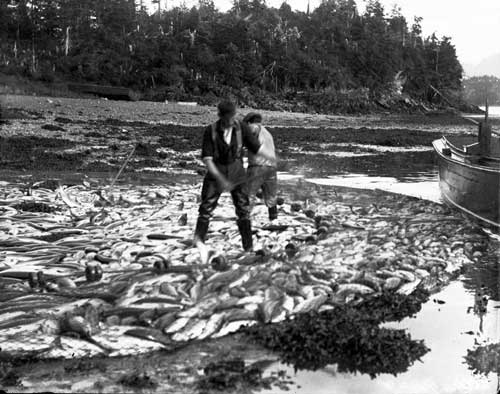 Willis A. Bryant photo; Donor: Arthur Bryant Photograph courtesy Tongass Historical Society 70.7.5.75 There are five species of salmon and each one has at least two names. The largest species, the King or Chinook, is also the smallest in number, but it's size ranging up to 100 pounds - and quality make it the money fish for many of the region's fishermen. The Coho or Silver Salmon is the mainstay of many of the charter and troll fishermen. The Chum or Dog salmon, the Sockeye or Red salmon and the Humpback or Pink salmon are the backbone of the net fisheries and, as thus, the fish that are most important to the salmon canning industry. After harvesting these fish, the industry always faces its most challenging task, getting the product to market in a form that is still fresh enough to encourage consumption. Geographically, Southeast Alaska is hundreds and thousands of miles away from the consumers who are going to eat the fish. The logistics of the situation are further hampered by the short season, in which millions of salmon come in to spawn in a matter of weeks. In these weeks, enough money has to be made to cover the costs of the facilities, the fishermen, and the shore workers. Since time is of the essence, canneries tend to be built as close as possible to spawning streams. This is crucial because few things spoil faster than a fresh salmon. Fish have to go from net to can in no more than a couple of days or they end up barely fit for fertilizer. This has been the big problem for nearly every group that has tried to profit from the Ketchikan area's "Silver Horde." Even the Native population, which has used the salmon for subsistence, has to deal with the issue of spoilage and, over the centuries, developed complex drying and smoking techniques to ensure the summer's bounty could feed the tribe during the fallow winter months. Native fishermen had lived off the abundant runs for generations, using a variety of methods from spears and nets to complex beach weirs that used the receding tide to trap the salmon. Each family would catch and process hundreds of pounds of salmon for its winter needs. The Russians, who owned Alaska up until 1867, also tried salmon harvesting and processing around New Archangel (modern day Sitka) with limited success. Many Russian traders and outposts relied on local Natives to provide them with salmon in the winter. Alaska Packers Had 80 Percent Of The Market One of the first commercial ventures started after the U.S. purchased Alaska in 1867 was a saltery built by Charles Baranovich, a Yugoslav immigrant who married the daughter of Chief Skowl. His saltery and trading post operated for several years near Karta Bay on the east side Prince of Wales Island. Another saltery operated at the native village of Klawock on the west coast of Prince of Wales Island. In 1878, the North Pacific Trading and Packing Company purchased that saltery and built the first cannery in Alaska. The plant was moved across the bay after a fire in 1899 and continued to operate until 1930. The Alaska Packers Association Cannery in Loring was originally operated by the Cutting Packing Company which had built a cannery in Sitka in 1878. It built the Loring plant in 1888, which was the height of the first salmon boom. In 1888, there were 37 canneries in Alaska and dozens more in British Columbia and Washington state. But the market became glutted with canned fish products and by 1892, only 15 canneries were left in Alaska. More than half of those including the Cutter Packing Plant in Loring, started a joint marketing group in 1891. By 1893, they had merged into the Alaska Packers Association which had a near monopoly of 80 percent of the market by the turn of the century. Even with that monopoly, the APA was concerned enough to fight attempts by other canneries, like Fidalgo Island, to "poach" on its territory. As other independent canneries moved into the region, the APA market share dropped, down to 50 percent by 1909. But in those days, Loring was still a booming village with canneries, stores and the largest salmon hatchery in the world, before Ketchikan eclipsed it in importance. Loring is now a small community of less than a dozen homes. In the first decade of its incorporation, Ketchikan went slowly about becoming a city. Hydroelectric power was established, a phone system was put in place, businesses sprang up in what is now the downtown area and that area generally took the shape that you see today. Because the Ketchikan Creek tideflats dominated the topography, much of the new buildings were on pilings or fill. The buildable land was limited and the hillsides steep.
That's why Ketchikan is often called 15 miles long and three blocks wide. It was the development of the canning industry and its need for room for canning buildings, bunkhouses and warehouse space that caused Ketchikan to branch out beyond its original narrow footprint at the mouth of Ketchikan Creek. Halibut Fishery Once Rivaled Salmon Canning In the early decades of the century, the cannery industry wasn't the only major fishery. In fact, one of the most common fishing vessels seen at the Ketchikan docks in the early years was the halibut schooner. Halibut had been a prime target of the Native fishermen as well, primarily because it, unlike salmon, was available year round. The Tlingit and Haida carved hooks and wove cedar fibers, animal intestines and kelp stems into lines to catch the bottom dwelling flatfish. The first commercial halibut harvests began in the region in the late 1890s. In those days, the fish were caught from small dories that then returned the fish to a "mother" ship, usually a sailing sloop or a schooner. There the halibut were packed in crushed ice and then taken to the Seattle area for. At one point, in 1895, Mike Martin and George Clark handled these shipments from Ketchikan. By 1907, larger companies, such as the New England Fish Co., were eyeing the Ketchikan area for a year-round halibut fishery. New England eventually chose Ketchikan as a cold storage site because of its proximity to the proposed railhead in Prince Rupert. The cold storage was completed and the first halibut were landed in September of 1909. Since Ketchikan was the official port of entry for Alaska, all halibut vessels enroute to any of the Alaskan fishing grounds even the Gulf of Alaska and the Bering Sea had to stop over. And so Ketchikan became the main outfitter for this burgeoning fleet, as well as the growing fleet of local vessels. These 60-80 foot schooners with their aft cabins and twin stubby masts soon crowded the waterfront. By the early 1930s, more than 6 million pounds were being landed each year. The industry peaked in the late 1960s at nearly 9 million pounds. But by the early 1970s, the industry had crashed, and less than a million pounds were coming in each year. Over the next two decades, the industry continued to contract until the point that a "derby" was instituted in which commercial fishermen were only allowed to fish for halibut for a couple of days each year. In recent years, fishermen have been granted a halibut quota that allows them to fish throughout the year, but now the commercial catch is made primarily by salmon fishermen going after halibut during breaks in the salmon seasons. The independent halibut fleet no longer exists in Alaska, and only the rare old schooner is seen along the waterfront. Other Fisheries Developed Over the years other seafood industries have waxed and waned in the Ketchikan area. Early attempts were made to harvest the plentiful crab and shrimp populations, and those continue to this day, but most of the those harvests have centered around Petersburg to the north. In the 1950s, Seattle merchant Ivar Wendt put a crab processing operation in the Ketchikan Cold Storage Building and it had some success for about five years, until the local crab populations began to drop. Another prominent fishery over the years has involved the herring, the smaller fish that is the major food for the returning salmon. Originally, herring were caught and reduced to oil and fishmeal in the Sitka, but there was a thriving herring harvest for bait in Ketchikan in the early 1900s. This fishery continues, though it is highly dependent on herring populations. A more common fishery for the past couple of decades has been for the herring eggs. The roe is considered a delicacy in Japan, driving prices for the herring upward of $1,000 a ton. This is a highly concentrated fishery which revolves around the spawning of the herring which usually takes a week or less each spring. In recent years, political debates have arisen as the herring have moved their spawning grounds from the traditional Kah Shakes area across the Revilla Channel to islands near the Annette Island Indian Reserve. The number of herring returning to spawn in this fishery has also varied widely, causing the state to limit and occasionally cancel the fishery in recent years. 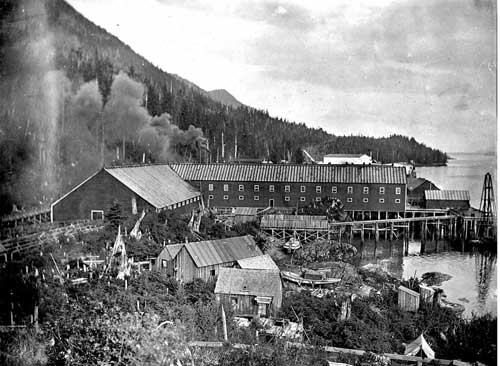 Harriet Hunt photo; Donor: Mary E. Row, Photograph courtesy Tongass Historical Society 86.1.35.161
Another commercial fishery of relatively recent years is the commercial dive fishery that involves divers harvesting sea urchins, sea cucumbers and abalone. These fisheries are being closely monitored by the State Department of Fish and Game to see how much can be harvested without damaging the stocks such as happened in other fisheries. Only Four Canneries Operated in Downtown Core But over the years the primary fishing industry has remained the salmon canning industry. Interesting enough, only four canneries have operated in the downtown core of Ketchikan an area bordered by the tunnel between Front and Water streets to the north and the Stedman Street bridge which crosses Ketchikan Creek to the south: The Tongass Packing Co (1887-1889), the Pure Food Fish Co. (1912- 1930), Sunny Point Canning Co. (1919-1923) and Northern Fisheries (1937 1942). The Fidalgo plant, which started the boom, was actually built on what was then considered the southern outskirts of the community, lying well south of the Creek and beyond Inman Hill. Fidalgo, as such, set the tone for out-of-town canneries and was followed by the New England Fish Co. in 1908 to the south, the Walsh Moore Canning Co. (in Ward's Cove to the north) in 1912, the George Inlet Packing Co. (12 miles south) in 1914 and the J.L. Smiley Co. (Wolfe Point to the north) in 1916. The development of the Fidalgo and New England facilities spurred Ketchikan to spread out to the south, across the Creek and down what is now Stedman Street through the area known in the early years as Indian Town. In 1902, a trail from the Creek to the Fidalgo cannery was replaced by a plank walk and was linked to the downtown over a small bridge. The NEFCO plant further extended this boardwalk as did the 1919 establishment of the U.S. Lighthouse Service base (now the Coast Guard base) to the south of the New England plant. By the time the growing city dredged the mouth of the Creek to form the Thomas Basin boat harbor in the early 1930s, the boardwalk had become a full-fledged thoroughfare, Stedman Street. 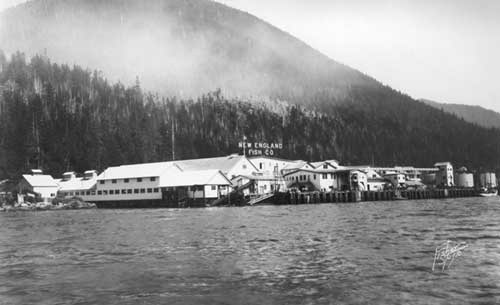 New England Fish Company Photo Album Donor: Howard Lee, Tongass Historical Society Photograph courtesy Ketchikan Museums
The Smell of Money In the Air The canning industry also expanded Ketchikan's boundaries to the north, first into the Newtown area and then even farther out into the West End. The first cannery to locate north of the downtown area was Revilla Fish Products which opened in 1912 and closed after one year. It was located just north of the current location of City Float. Rising salmon prices and the widespread use of fish traps made 1912 an important year for canneries in the region, with 22 starting up in Southeast Alaska. Most only operated for a couple of years, but that didn't stop new enterprises from springing up on the waterfront between the tunnel and the Captain's Hill area of Newtown. The Sparhawk Cannery opened up in 1916, Beegle Packing replaced the Revilla in 1916, Sunrise Packing in 1923 and Ketchikan Packing Co. in 1931. The new canneries drove growth in the Newtown area as they had in the Stedman district and now marine related business, bars and restaurants moved out of the downtown to take advantage of the new commercial zone along Water Street and Hopkins Alley. Residential areas quickly sprang up on the nearby hillsides. As waterfront space disappeared in Newtown, other canneries pushed city boundaries farther to the north in order to find the room they needed. Sunny Point moved from downtown in the early 1920s out to a huge site near Charcoal Point, three miles from downtown, and became one of the largest, most modern canneries in the world. It operated until the late 1950s and is now the site of the Ketchikan Shipyard. 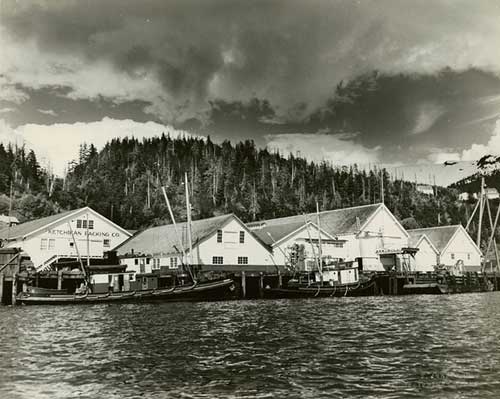 Sixten Johanson photo; Donor: Sixten Johanson Photograph Courtesy Tongass Historical Society 70.12.5.5
Overharvest Took Its Toll On the Industry In order to help the World War II war effort, the government ordered several local canneries to consolidate to save on manpower and supplies. The remaining half-dozen canneries operated at full steam because the canned salmon was used to help feed the troops. It was only towards the end of the war that Spam replaced Alaska salmon as the ubiquitous entrée for the military. Many local fishermen and cannery workers received draft deferments because they were involved in food production just like the American farmers in the Mid-West. After the war, several of the shuttered facilities didn't reopen, primarily because the salmon harvest was down. By the early 1950s, only five canneries were open and the industry was hanging by a thread. Too many years of too efficient harvesting left the salmon runs at only a shadow of their former size. The biggest culprit was the fishing method that the canneries had pioneered as their mainstay, the fish trap. Traditionally, fishermen had used a variety of means to harvest the salmon and the most popular were net fisheries near the mouths of creeks. These net fisheries were a fairly efficient way to harvest from the large schools of fish pooling in salt water near creek mouths, waiting to make their run up the streams to spawn. Eventually, it was recognized that not enough fish were getting through the forest of beach nets to ensure future runs, so they were limited and replacement by floating nets strung from the backs of fishing boats such as purse seiners or gillnetters. These net fleets were kept further offshore and allowed to intercept the schools of fish as they traveled to their spawning grounds. This was a less efficient way to catch fish and also involved higher costs than beach netting. As the cannery industry began growing, and thus required larger supply of fish, a new method came on the scene. 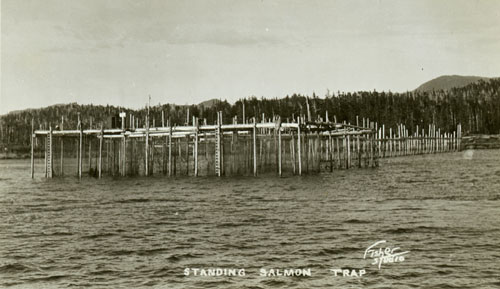 Photographer: Elliott Fisher; Donor: Norman A MacDonald Photograph courtesy Tongass Historical Society 96.2.31.5
At first traps were limited to shallow water locations because they had to driven or secured to the land to stay in place. But in 1907, J.R. Heckman, of the Alaska Packers Association, developed a floating trap, held in place by huge sea anchors. This meant that more traps could be put in more locations and that led to the boom in the canning industry in the 1910s. At one point, nearly 200 traps were in operation in the Ketchikan area. By the 1950s, widespread use of the traps led to closures in the fishing industry in order to try to build the salmon runs back up. These closures hit Ketchikan hard, but although the elimination of traps was a main platform of the pro-statehood supporters, many in Ketchikan took the anti-statehood side. By then nearly all of the remaining local canneries were controlled by Seattle companies and those companies favored retaining the traps and retaining territorial status for Alaska. It was their belief that the federal government would continue to look after their interests as it had since the founding of Ketchikan. Statehood Ended Fish Traps But even without Ketchikan's wholehearted support, voters opted for statehood and even though state government conservation methods eventually restored salmon runs to high levels the salmon canning industry continued in decline. It reached its bottom in 1971 when no cases of salmon were canned in Ketchikan and the "Salmon Capital of the World" welcome arch seemed only to mock the once proud industry. In recent years, two or three canneries have operated in the Ketchikan area and packed in the vicinity of 500,000 cases a year. While this is less than half of what Ketchikan's canning industry once packed, it has proven to be a sustainable amount. The remaining canneries have continued to modernize and work cooperatively by pooling resources, fishing fleets and allocations, updating their distribution systems and improving their technology to make the canning more efficient and less costly. This cooperation is far cry from the days when guns were drawn to protect valuable creek mouths. Salmon canneries are no longer the economic engine driving Ketchikan but the fishing industry still represents a large portion of the town's economy and on sunny summer days, when the breeze is just right, you can still find the "smell of money" in the air along Ketchikan's water front.
On the Web:
Dave Kiffer is a freelance writer living in Ketchikan, Alaska. To republish this article, the author requires a publication fee. Contact Dave at dave@sitnews.us Dave Kiffer ©2009
|
||
